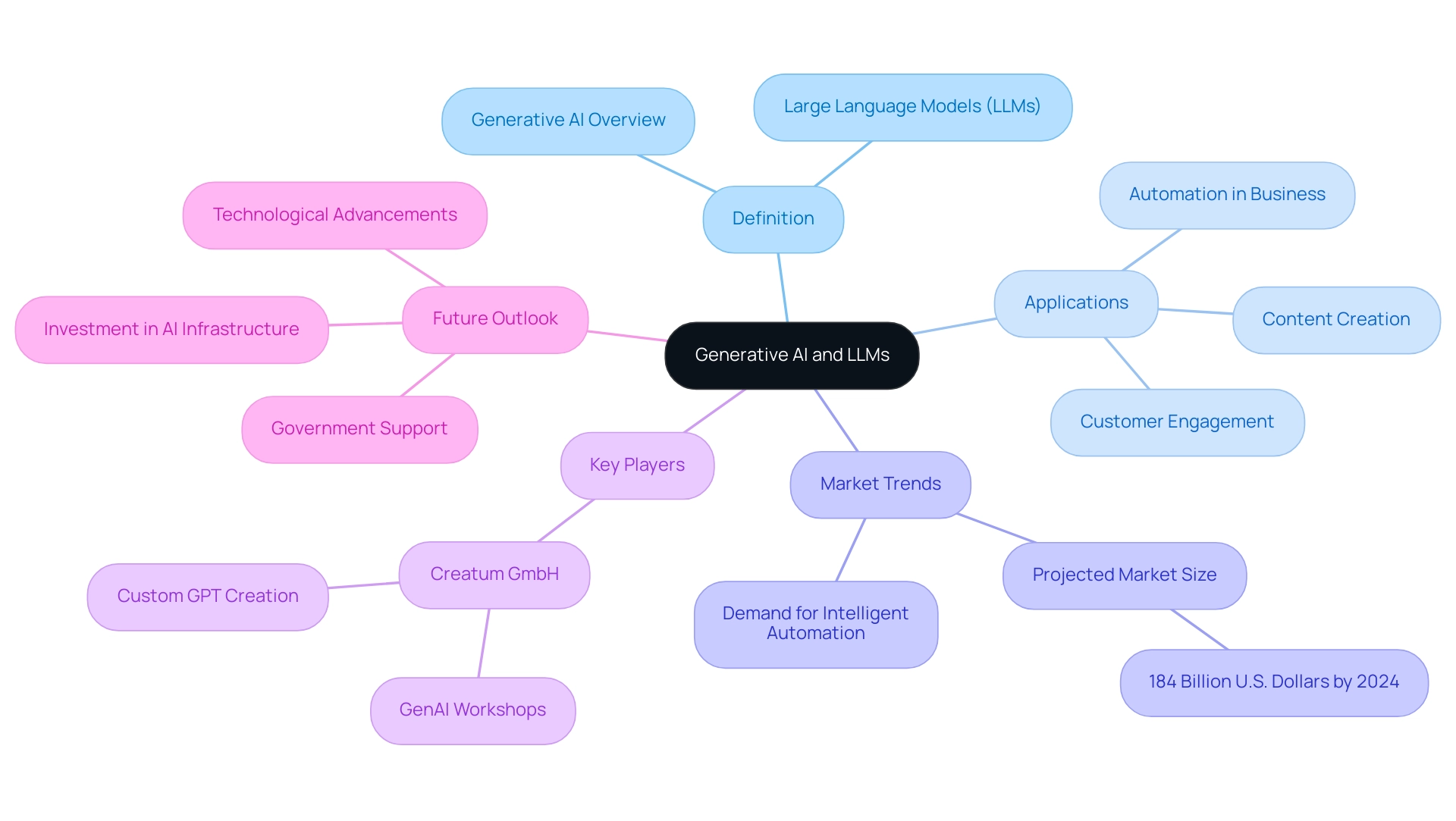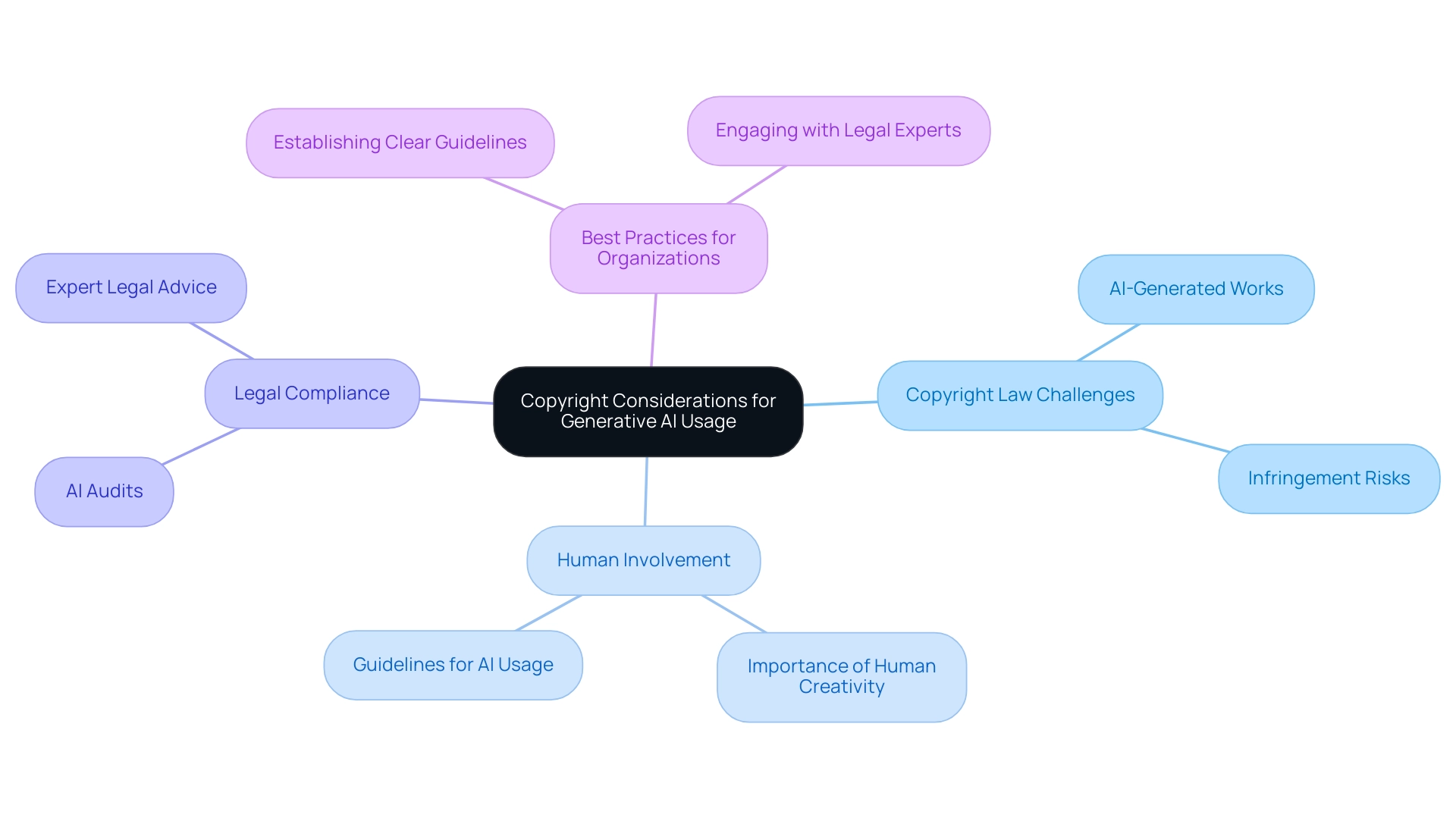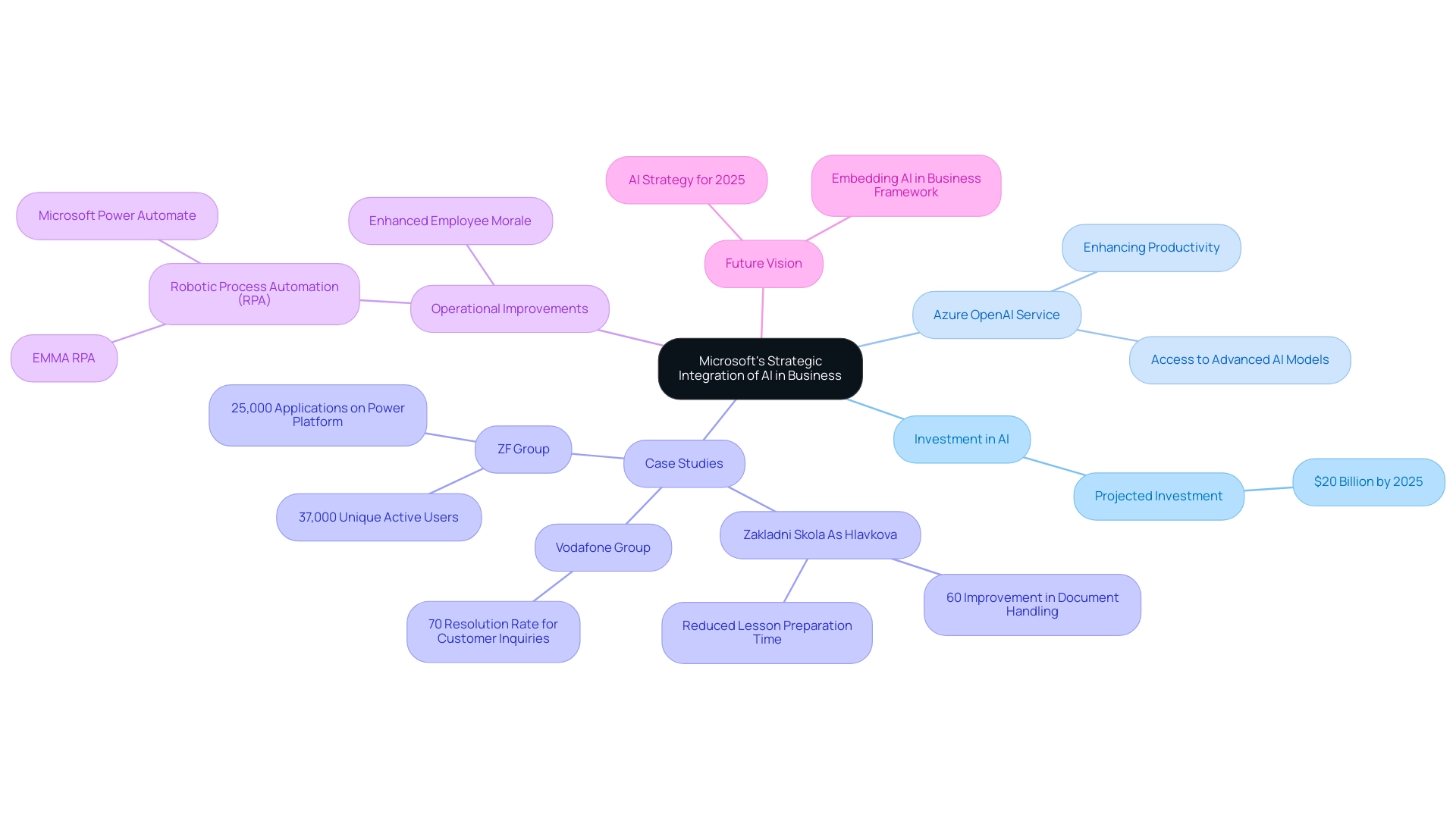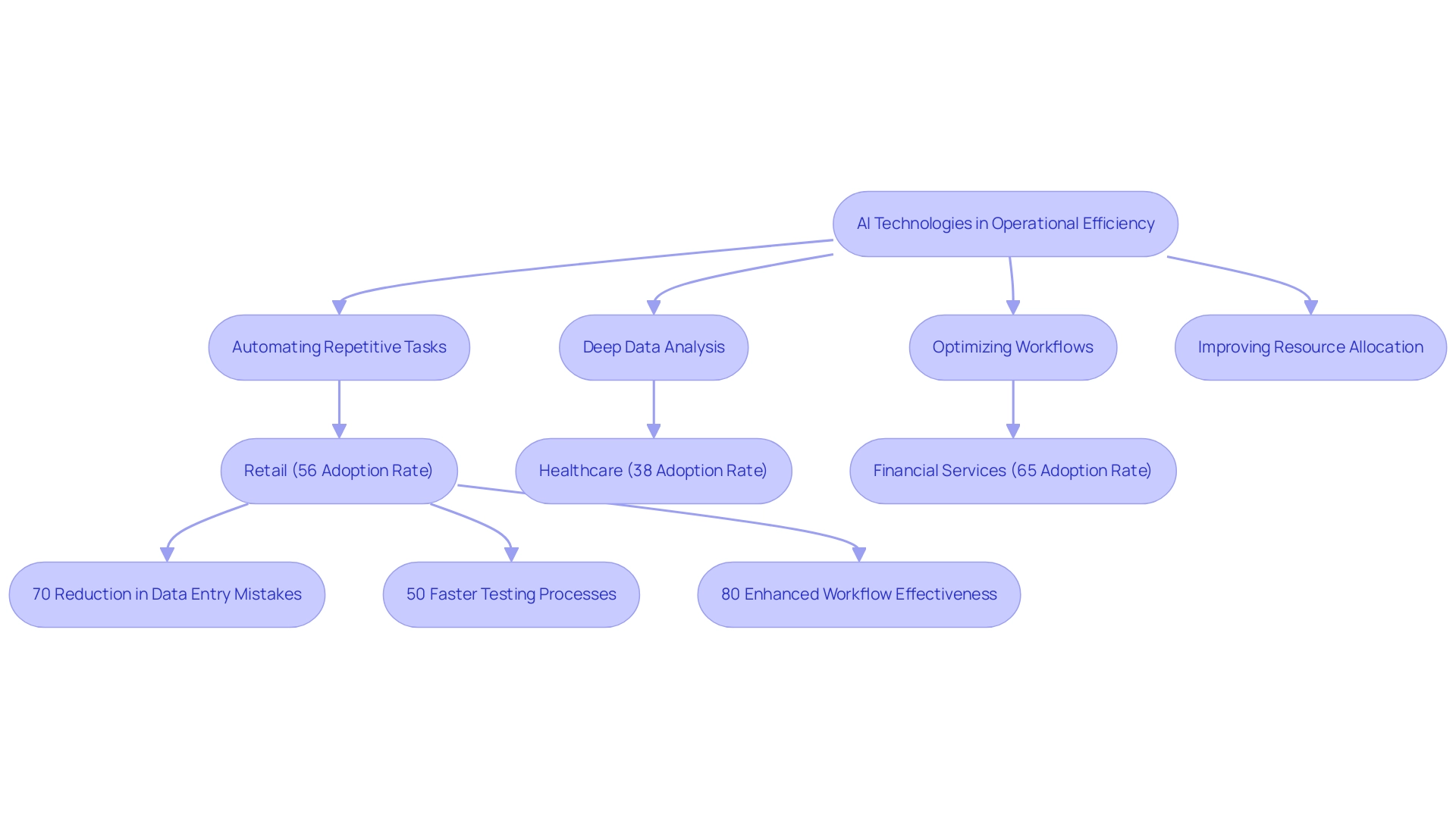Overview
Mastering AI LLM commercial use requires a deep understanding of Microsoft’s strategic integration of AI technologies, aimed at enhancing business operations and productivity. Microsoft’s substantial investments in AI, such as the Azure OpenAI Service, exemplify this commitment. This service has successfully streamlined processes for various organizations, showcasing the effectiveness of AI in driving innovation and efficiency across sectors.
How can your organization leverage these advancements to transform its operations? Embracing such technologies may hold the key to staying competitive in an evolving market.
Introduction
In the rapidly evolving landscape of artificial intelligence, generative AI and Large Language Models (LLMs) are not merely buzzwords; they are redefining how businesses operate and engage with their customers. This significant shift towards automation and intelligent content generation enables organizations to enhance productivity and streamline operations.
With the generative AI market projected for substantial growth, understanding its implications on content ownership, copyright considerations, and strategic integration becomes imperative. Companies aiming to leverage these innovations effectively must navigate this new terrain.
Microsoft, among others, is leading the charge in AI integration, revealing vast potential for improved operational efficiency and innovation.
This article delves into the transformative power of generative AI, exploring its applications, challenges, and the future it holds for organizations across various sectors.
Understanding Generative AI and Large Language Models (LLMs)
Generative AI represents a sophisticated class of artificial intelligence capable of producing new content—ranging from text and images to audio—based on extensive training data. Within this domain, Large Language Models (LLMs) emerge as a specialized subset designed to comprehend and generate human-like text. Notable examples include GPT-3 and its successors, which leverage advanced deep learning techniques to process and analyze vast datasets of text.
This capability empowers LLMs to generate coherent, contextually appropriate responses, positioning them as invaluable tools for commercial applications, particularly in enhancing business operations and driving productivity through automation.
Looking ahead, the generative AI market is projected to experience significant growth by 2025, fueled by an increasing demand for intelligent automation across various sectors. The global AI market is expected to reach approximately 184 billion U.S. dollars, reflecting a robust trend towards integrating AI solutions for improved efficiency and cost reduction. Notably, content creation and the classification of customer interactions are emerging as leading use cases for generative AI in call centers, showcasing its potential to transform customer engagement strategies and streamline workflows through Robotic Process Automation (RPA).
As Bernard Marr observes, “The staggering investment levels, impressive ROI reports, and accelerating adoption rates signal a technology crossing the threshold from emerging to essential.” This perspective underscores the critical role of generative AI and RPA in contemporary practices. Additionally, the growth of the Generative AI market is influenced by macroeconomic factors, including technological advancements and government support, which foster a favorable environment for AI adoption.
Recent advancements in LLMs have further solidified their role in enhancing organizational efficiency. Companies increasingly adopt these technologies to streamline workflows, reduce operational errors, and allow teams to focus on strategic initiatives. Successful implementations of LLMs in enterprises demonstrate their effectiveness in driving innovation and growth, particularly in data-rich environments.
By utilizing customized AI solutions from Creatum GmbH and Business Intelligence, organizations can transform raw data into actionable insights, enabling informed decision-making that propels growth.
Understanding the mechanics of generative AI and LLMs is essential for organizations aiming to leverage these technologies. As the landscape evolves, staying informed about current trends and expert opinions will be crucial for maximizing the benefits of generative AI, ensuring organizations navigate the complexities of AI adoption effectively while replacing outdated systems with innovative solutions. Furthermore, Creatum GmbH offers GenAI workshops that provide hands-on training and custom GPT creation, addressing the challenges organizations face in implementing AI solutions.

Navigating Content Ownership in AI Creations
As generative AI becomes increasingly integrated into organizational operations, the issue of ownership of material produced by these systems has emerged as a critical concern. Legal frameworks in many jurisdictions are still evolving to keep pace with these technological advancements, resulting in considerable ambiguity. Typically, the user who prompts the AI retains rights to the output; however, this can vary significantly based on the specific terms of service established by the AI provider.
To navigate this complex landscape effectively, companies must proactively establish clear policies regarding ownership. This is essential not only to mitigate potential disputes but also to ensure compliance with existing intellectual property laws. Recent statistics reveal that 30% of business owners expect AI to generate website copy for their companies, underscoring the growing reliance on AI-generated material.
Yet, with this reliance comes the risk of ownership disputes, which are anticipated to rise as more organizations adopt these technologies. Legal opinions on AI ownership rights are gaining prominence, particularly as existing frameworks struggle to address the nuances of AI-generated works. For instance, a recent case study titled ‘Modifying AI-Generated Material for Copyright‘ indicated that while wholly AI-generated works lack copyright protection, modifications made by humans can meet originality standards, potentially allowing for copyright claims on those contributions. This highlights the importance of human involvement in the creative process to secure ownership rights.
As Zach Lewis aptly noted, “AI hasn’t turned copyright law on its head. At least not yet.”
Moreover, statistics indicate that 41% anticipate AI being utilized to rectify coding mistakes efficiently, further demonstrating AI’s capabilities and significance in generation. Additionally, 64% assert that the primary purpose of AI is to assist, enhance, and empower consumers, reinforcing the narrative surrounding AI’s role in operational activities.
In this context, our AI-based junior consultant, Hayley, is equipped to provide tailored insights to help organizations navigate these challenges effectively. Hayley can assist in developing clear policies regarding ownership of materials and understanding the legal implications of AI-generated works. As we progress through 2025, it is essential for companies to remain vigilant about the evolving legal landscape concerning AI-generated material.
Establishing robust policies and comprehending the implications of content ownership will be crucial for leveraging AI technologies effectively while safeguarding intellectual property rights. We invite you to engage with Hayley to explore how our tailored AI solutions at Creatum GmbH can support your organization in navigating these complexities.

Copyright Considerations for Generative AI Usage
Copyright law presents significant challenges for enterprises leveraging generative AI technologies. As of 2025, existing regulations typically do not recognize AI-generated works as copyrightable unless substantial human involvement is evident in their creation. This creates a precarious landscape for companies utilizing generative AI, compelling them to navigate the risks of infringing on existing copyrights.
To mitigate these risks, companies should conduct thorough audits of their AI-generated materials and seek expert legal advice to ensure compliance with copyright regulations.
Recent statistics reveal that half of enterprise owners expect AI to enhance their decision-making processes, underscoring the growing reliance on AI technologies. However, this reliance brings with it the responsibility to comprehend the legal implications. For instance, the Copyright Office’s AI Initiative, launched in early 2023, explored the intersection of copyright and AI, gathering insights from over 10,000 public comments.
The findings emphasized the importance of human creativity in copyright law, leading to suggestions for future legislation that addresses the unique challenges posed by AI-generated material. This initiative serves as a crucial learning point for organizations navigating copyright laws, highlighting the necessity of human oversight in AI-generated works.
Moreover, entities must remain cognizant of the copyright challenges associated with generative AI. A notable case study involves companies that have successfully navigated these complexities by establishing clear guidelines for AI usage and ensuring that their creation processes incorporate significant human oversight. As generative AI continues to evolve, staying informed about current legal precedents and actively engaging with legal experts will be essential for organizations aiming to harness the benefits of AI while remaining compliant with copyright laws.
Furthermore, with the integration of Robotic Process Automation (RPA) and customized AI solutions, organizations can enhance operational efficiency, automate repetitive tasks, and ensure that their AI-generated materials deliver genuine value. By 2028, it is projected that 20% of repetitive processes will be automated through domain-specific Generative AI implementations, further underscoring the need for organizations to adapt to these changes while maintaining compliance. As the Course Creator aptly noted, while embracing AI technology is crucial, it is equally important to avoid perceptions of laziness or unreliability by ensuring that AI-generated content is strategically aligned with organizational goals.

Microsoft’s Strategic Integration of AI in Business
Microsoft has firmly established itself as a frontrunner in AI integration, with substantial investments in AI technologies and platforms projected to exceed $20 billion by 2025. The Azure OpenAI Service stands out as a pivotal offering, granting organizations access to advanced AI models that significantly enhance productivity and streamline operations. By seamlessly integrating AI capabilities into widely utilized products such as Microsoft 365, the company empowers organizations to automate repetitive tasks, improve decision-making processes, and foster innovation across various sectors.
Recent developments underscore this commitment. Organizations like Zakladni Skola As Hlavkova have successfully adopted Microsoft 365 Copilot, leading to a remarkable 60% improvement in administrative document handling. They noted, “adopted Microsoft 365 Copilot and saw a 60% improvement in handling administrative documents, decreased lesson preparation from hours to a few minutes, increased inclusivity and enhanced communication with students and parents.” This integration has notably reduced lesson preparation time from hours to mere minutes, showcasing the tangible benefits of AI in educational settings.
Similarly, Vodafone Group has achieved a 70% resolution rate for customer inquiries through digital channels, illustrating how Microsoft’s AI solutions enhance customer service by streamlining interactions and improving response times.
The market share of Microsoft Azure OpenAI Service is expected to expand considerably by 2025, reflecting the growing interest in AI commercial use among companies aiming to leverage AI for operational effectiveness. Case studies, such as ZF Group’s implementation of over 25,000 applications on the Power Platform, reveal substantial operational improvements, with 37,000 unique active users benefiting from streamlined processes. This demonstrates the effectiveness of Microsoft’s solutions in real-world applications.
Moreover, the integration of Robotic Process Automation (RPA) solutions like EMMA RPA and Microsoft Power Automate further enhances productivity and employee morale. EMMA RPA offers a revolutionary tool for operational efficiency, while Power Automate transforms operations with its user-friendly digitalization capabilities. These tools facilitate process automation, allowing organizations to achieve risk-free ROI evaluations and professional execution of workflows.
Microsoft executives have articulated a clear vision for AI strategy in 2025, emphasizing the importance of embedding AI into their business framework to maintain a competitive edge. Expert analyses further highlight how this integration not only enhances Microsoft’s product offerings but also positions the company as a leader in the evolving technology landscape, driving growth and innovation across industries. Creatum GmbH is dedicated to utilizing these advancements to enhance operational productivity and employee morale.

Leveraging AI for Enhanced Operational Efficiency
AI technologies are revolutionizing operational efficiency by automating repetitive tasks, providing deep data analysis for actionable insights, and optimizing workflows. Businesses utilizing AI-driven analytics can identify bottlenecks in their operations, enabling them to implement targeted solutions that minimize downtime and enhance productivity. The adoption of AI in retail has reached an impressive 56%, reflecting a broader trend where 83% of companies prioritize AI in their strategic plans.
Moreover, AI facilitates improved resource allocation by accurately predicting demand and adjusting operations accordingly. This capability not only streamlines processes but also allows organizations to reallocate valuable human resources towards more strategic initiatives, fostering innovation and growth. RPA solutions from Creatum GmbH, such as EMMA RPA and Microsoft Power Automate, exemplify this trend by improving productivity and employee morale through innovative automation tools that simplify complex workflows and reduce manual effort.
Case studies illustrate this trend: in the healthcare sector, which has seen a 38% adoption rate of AI, organizations are utilizing AI to enhance patient care and operational workflows, leading to improved patient outcomes and productivity. A notable case study involved a mid-sized company that enhanced productivity by automating data entry, software testing, and legacy system integration using GUI automation. This implementation reduced data entry mistakes by 70%, accelerated testing processes by 50%, and enhanced workflow effectiveness by 80%, achieving ROI within six months.
Similarly, financial services, boasting a 65% adoption rate, are employing AI to optimize risk management and customer service operations, resulting in faster response times and better client satisfaction. These examples underscore the significant role AI plays in enhancing operational efficiency across various industries.
As Michael Chui, a Senior Fellow, notes, the momentum behind AI—encompassing both generative and analytical forms—continues to build, indicating a robust future for AI-driven operational improvements. This momentum is further reflected in the competitive landscape, where AI startups are enjoying higher valuations than their non-AI counterparts, presenting lucrative opportunities for businesses willing to embrace these technologies.
With investment in generative AI reaching $25.2 billion in 2023, organizations that integrate AI into their operations can not only streamline workflows but also position themselves for sustained success in an increasingly data-driven world.

Conclusion
The transformative potential of generative AI and Large Language Models (LLMs) is increasingly evident across various sectors. As businesses strive for enhanced operational efficiency, integrating these technologies is not merely an option; it is a necessity. Companies leveraging generative AI can significantly automate content creation, streamline workflows, and improve customer engagement, ultimately driving productivity and innovation.
However, the journey toward effective AI integration presents challenges. Issues surrounding content ownership and copyright considerations create complex legal landscapes that organizations must navigate carefully. Establishing clear policies on content ownership and understanding the implications of copyright laws are essential steps for businesses to protect their intellectual property while harnessing the power of AI-generated content.
Industry leaders like Microsoft exemplify how strategic integration of AI tools can lead to remarkable improvements in operational efficiency. The success stories of companies utilizing AI solutions underscore the tangible benefits of adopting these technologies, from reducing administrative workloads to enhancing customer service interactions. Organizations prioritizing AI in their strategic planning are likely to experience significant advantages in a competitive marketplace.
In conclusion, embracing generative AI and LLMs is crucial for organizations aiming to thrive in an increasingly automated and data-driven world. By staying informed about emerging trends and legal considerations, businesses can effectively navigate the evolving landscape of AI, transforming potential challenges into opportunities for growth and innovation. As the market for generative AI continues to expand, those who adapt and integrate these technologies will be well-positioned for success in the future.
Frequently Asked Questions
What is generative AI?
Generative AI is a sophisticated class of artificial intelligence capable of producing new content, including text, images, and audio, based on extensive training data.
What are Large Language Models (LLMs)?
LLMs are a specialized subset of generative AI designed to understand and generate human-like text, with notable examples including GPT-3 and its successors.
How do LLMs benefit businesses?
LLMs enhance business operations and drive productivity through automation by generating coherent and contextually appropriate responses.
What is the projected growth of the generative AI market by 2025?
The generative AI market is expected to grow significantly, with the global AI market projected to reach approximately 184 billion U.S. dollars, driven by increasing demand for intelligent automation.
What are some leading use cases for generative AI in call centers?
Content creation and the classification of customer interactions are emerging as leading use cases for generative AI in call centers, transforming customer engagement strategies and streamlining workflows.
What macroeconomic factors influence the growth of the generative AI market?
Technological advancements and government support are key macroeconomic factors that create a favorable environment for AI adoption.
How are organizations using LLMs to improve efficiency?
Organizations adopt LLMs to streamline workflows, reduce operational errors, and allow teams to focus on strategic initiatives, demonstrating their effectiveness in data-rich environments.
What role does Creatum GmbH play in AI implementation?
Creatum GmbH offers customized AI solutions and GenAI workshops, providing hands-on training and custom GPT creation to help organizations implement AI solutions effectively.
What is the current issue regarding ownership of AI-generated material?
The ownership of material produced by generative AI is a critical concern, with legal frameworks evolving and users typically retaining rights to the output, depending on the AI provider’s terms of service.
What are the implications of human involvement in AI-generated works?
While wholly AI-generated works may lack copyright protection, modifications made by humans can meet originality standards, potentially allowing for copyright claims on those contributions.
How can organizations navigate the complexities of AI content ownership?
Companies should establish clear policies regarding ownership of AI-generated materials to mitigate disputes and ensure compliance with intellectual property laws.
What assistance does the AI-based junior consultant, Hayley, provide?
Hayley offers tailored insights to help organizations develop clear policies regarding ownership of materials and understand the legal implications of AI-generated works.

